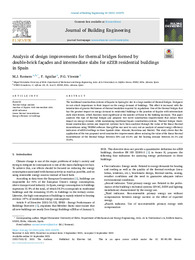Por favor, use este identificador para citar o enlazar este ítem:
https://hdl.handle.net/11000/37948Registro completo de metadatos
| Campo DC | Valor | Lengua/Idioma |
|---|---|---|
| dc.contributor.author | Romero-Rincón, Manuel Jesús | - |
| dc.contributor.author | Aguilar-Valero, Francisco Javier | - |
| dc.contributor.author | Vicente-Quiles, Pedro G. | - |
| dc.contributor.other | Departamentos de la UMH::Ingeniería Mecánica y Energía | es_ES |
| dc.date.accessioned | 2025-11-07T09:19:49Z | - |
| dc.date.available | 2025-11-07T09:19:49Z | - |
| dc.date.created | 2021-12 | - |
| dc.identifier.citation | Journal of Building Engineering, Vol. 44 (2021) | es_ES |
| dc.identifier.issn | 2352-7102 | - |
| dc.identifier.uri | https://hdl.handle.net/11000/37948 | - |
| dc.description.abstract | The traditional construction systems of façades in Spain give rise to a large number of thermal bridges. Designers do not attach importance to their impact on the energy demand of buildings. This effect is increased with the introduction of greater thicknesses of thermal insulation required by regulations. One of the thermal bridges that has the greatest impact on energy demand in residential buildings is the junction of façades with intermediate slabs (slab fronts), which becomes more significant as the number of floors in the building increases. This paper analyzes this type of thermal bridges and proposes two novel construction improvements that reduce their impact on energy demand, while maintaining traditional façade construction systems. Thermal bridges (traditional construction system and improved systems) have been analyzed through the value of the linear thermal transmittance using THERM software. EnergyPlus was used to carry out an analysis of annual energy efficiency indicators of nZEB dwellings in three Spanish cities: Alicante, Barcelona and Madrid. This study shows that the application of the two proposed novel constructive improvements allows reducing the value of the linear thermal transmittance of the thermal bridge between 20% and 63.4% and the heating demand between 16.1% and 22.6%. | es_ES |
| dc.format | application/pdf | es_ES |
| dc.language.iso | eng | es_ES |
| dc.publisher | Elsevier | es_ES |
| dc.rights | info:eu-repo/semantics/openAccess | es_ES |
| dc.rights | Attribution-NonCommercial-NoDerivatives 4.0 Internacional | * |
| dc.rights.uri | http://creativecommons.org/licenses/by-nc-nd/4.0/ | * |
| dc.subject | Thermal bridge analysis | es_ES |
| dc.subject | Junction of façades with intermediate slabs | es_ES |
| dc.subject | nZEB indicators | es_ES |
| dc.subject | Linear thermal transmittance | es_ES |
| dc.subject | Energy efficiency in buildings | es_ES |
| dc.title | Analysis of design improvements for thermal bridges formed by double-brick façades and intermediate slabs for nZEB residential buildings in Spain | es_ES |
| dc.type | info:eu-repo/semantics/article | es_ES |
| dc.relation.publisherversion | https://doi.org/10.1016/j.jobe.2021.103270 | es_ES |

Ver/Abrir:
7_Analysis of design improvements for thermal bridges_JBE_2021.pdf
15,02 MB
Adobe PDF
Compartir:
 La licencia se describe como: Atribución-NonComercial-NoDerivada 4.0 Internacional.
La licencia se describe como: Atribución-NonComercial-NoDerivada 4.0 Internacional.
.png)